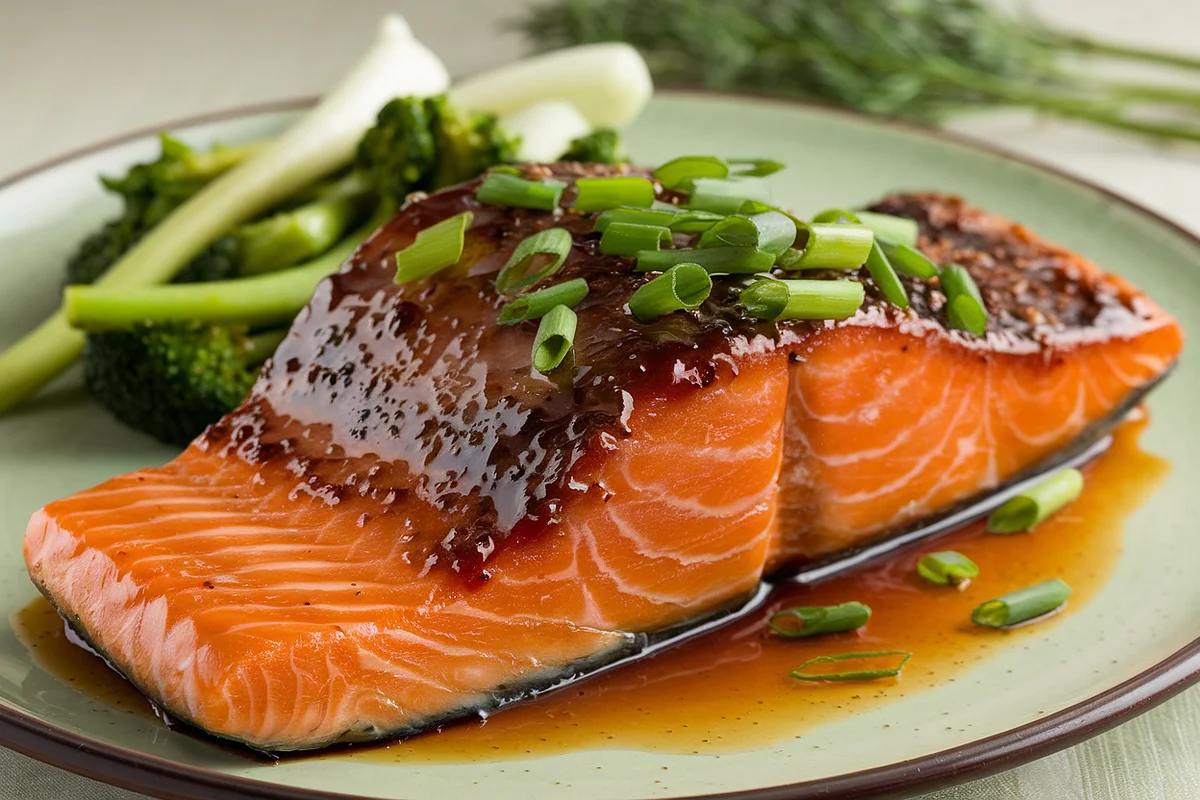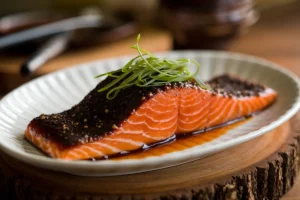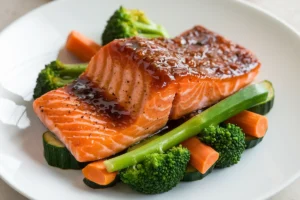If you’re looking for a flavorful and healthy meal, this miso salmon recipe is the perfect choice. Miso salmon combines the rich umami flavor of miso paste with tender, succulent salmon, creating a dish that is not only delicious but also easy to make. Whether you’re a novice cook or an experienced chef, this guide will walk you through every step of making the perfect miso salmon.
What is Miso?
At the heart of this dish is miso, a traditional Japanese ingredient made from fermented soybeans. Miso has been a staple in Japanese cuisine for centuries, adding an intense, savory depth of flavor known as umami. It comes in various types:
- White miso (Shiro Miso): Milder and sweeter, perfect for a lighter glaze.
- Yellow miso: Slightly stronger than white miso, but still versatile.
- Red miso: The most robust and salty, often used in heartier dishes.
Miso not only enhances the flavor of salmon but also adds a layer of complexity that makes this dish stand out. Its fermentation process also makes it a great source of probiotics, which are beneficial for gut health. Read more about the health benefits of fermented foods to understand how miso can be a nutritious part of your diet.
Why Salmon? The Health Benefits
Salmon is another star in this recipe, and it’s not just because of its rich flavor. Salmon is packed with Omega-3 fatty acids, which are crucial for brain health, heart health, and reducing inflammation in the body. Additionally, it’s an excellent source of high-quality protein, vitamin D, and B vitamins. Using salmon in your diet is a tasty and nutritious way to maintain a healthy lifestyle.
Moreover, it’s important to choose the right type of salmon. If possible, opt for sustainable seafood options, like wild-caught Alaskan salmon, to ensure you’re making environmentally responsible choices. To learn more about sustainability in seafood, check out the Monterey Bay Aquarium Seafood Watch for guidelines.
Essential Ingredients in Miso Salmon Recipe
To make the best miso salmon, you’ll need a handful of essential ingredients, many of which you may already have in your pantry. Here’s a breakdown:
- Miso paste: White or yellow miso works best for a balanced flavor.
- Soy sauce: Adds saltiness and deepens the umami flavor.
- Mirin: A sweet Japanese cooking wine that balances the savory ingredients.
- Sesame oil: Adds a nutty flavor that complements both the miso and the salmon.
- Fresh ginger and garlic: These aromatics enhance the overall taste profile.
- Rice vinegar or sake: Either of these can be used to add acidity, which helps cut through the richness of the salmon.
- Brown sugar or honey: Sweetness balances out the salty and savory elements.
- Fresh salmon fillets: Ideally wild-caught for better texture and flavor.
Ingredient Substitutes
If you’re short on any ingredients, here are some substitutes:
- Tamari instead of soy sauce (for a gluten-free option).
- Maple syrup instead of brown sugar.
- Olive oil instead of sesame oil (though this will slightly change the flavor).
Step-by-Step Miso Salmon Recipe
This miso salmon recipe is simple and versatile, making it perfect for a quick weeknight dinner or a more elaborate meal. You can cook it using various methods—oven-baked, broiled, or even in an air fryer.
1. Prepare the Miso Glaze
- In a small bowl, whisk together:
- 3 tablespoons of miso paste (white or yellow)
- 2 tablespoons of soy sauce
- 1 tablespoon of mirin
- 1 tablespoon of sesame oil
- 1 tablespoon of brown sugar (or honey)
- 1 teaspoon of freshly grated ginger
- 1 teaspoon of minced garlic
The mixture should be smooth and thick enough to coat the salmon evenly.
2. Marinate the Salmon
- Pat the salmon fillets dry and place them in a shallow dish.
- Pour the miso glaze over the salmon, ensuring each piece is well-coated.
- Cover and refrigerate for 30 minutes to 2 hours. The longer you marinate, the deeper the flavor.
3. Choose Your Cooking Method
- Oven-baked: Preheat the oven to 400°F (200°C). Place the salmon on a lined baking sheet and bake for 12-15 minutes, or until the salmon flakes easily with a fork.
- Broiled: Preheat your broiler. Place the salmon on a broiler pan and cook for 5-8 minutes, keeping a close eye to avoid burning the glaze.
- Air fryer: Set the air fryer to 375°F (190°C). Cook the salmon for 10 minutes, checking at the halfway mark.
4. Serve and Enjoy
- Once the salmon is cooked, serve it with your favorite side dishes like steamed rice or roasted vegetables.
Miso Salmon Recipe Variations
Miso salmon is a versatile dish, and there are plenty of ways to adapt the recipe based on your taste preferences and cooking methods. Here are some popular variations:
- Air Fryer Miso Salmon: For a crispier texture, the air fryer is a fantastic option. Follow the same recipe, but cook the salmon for about 10 minutes in an air fryer at 375°F.
- Miso Salmon with Vegetables: For a complete meal, roast vegetables like broccoli, carrots, or bok choy alongside the salmon. Simply toss the veggies in olive oil and soy sauce, then bake them on the same sheet as the salmon.
- Spicy Miso Salmon: Add a kick to the dish by mixing in a teaspoon of chili paste or Sriracha into the miso glaze.
- Grilled Miso Salmon on Skewers: Cut the salmon into cubes, marinate, and thread them onto skewers for a fun, grilled version of this recipe.
Expert Cooking Tips for the Perfect Miso Salmon
Cooking salmon can be tricky, but these tips will ensure your miso salmon comes out perfect every time:
- Don’t Overcook: Salmon is best when it’s slightly undercooked in the center. Aim for an internal temperature of 125°F (51°C).
- Use Fresh Ingredients: Fresh salmon, ginger, and garlic will provide the best flavor. Frozen salmon works in a pinch but fresh is always preferred.
- Marinate for Depth of Flavor: While 30 minutes of marination works, letting the salmon sit in the miso glaze for a full two hours will result in deeper, richer flavors.
- Preheat Your Cooking Equipment: Whether you’re using an oven, broiler, or air fryer, make sure it’s preheated for even cooking and a crispy finish.
What to Serve with Miso Salmon
A well-rounded meal needs the perfect side dishes. Here are some suggestions to complement your miso salmon:
- Steamed Rice: Simple, classic, and perfect for soaking up the miso glaze.
- Sesame Ginger Noodles: Add an extra layer of flavor with these lightly spiced noodles.
- Roasted Vegetables: Try asparagus, broccoli, or bok choy roasted with a bit of soy sauce and sesame oil.
- Pickled Vegetables: Japanese-style pickled cucumbers or radishes add a refreshing contrast to the rich salmon.
- Miso Soup: A light miso soup can enhance the overall meal experience.
For beverage pairings, a glass of dry white wine or a light, crisp beer can complement the dish nicely. Sake is also a traditional option.
FAQs About Miso Salmon
1. Can I use any type of salmon for this recipe?
Yes, but wild-caught salmon typically has better flavor and texture compared to farmed salmon.
2. Can miso salmon be frozen?
Yes, after cooking, let the salmon cool completely, then freeze it in an airtight container for up to 3 months.
3. Is it okay to leave out sugar or use a substitute?
You can replace brown sugar with honey or maple syrup for a healthier option. Omitting the sugar altogether may result in a less balanced flavor.
4. How long should I marinate the salmon?
For optimal flavor, marinate the salmon for at least 30 minutes, but up to 2 hours if time permits.
5. Can I use a different fish instead of salmon?
Absolutely! This miso glaze works well with other types of fish like cod, halibut, or even tuna.
6. How do I prevent the salmon from drying out?
The key is to not overcook the salmon. If using an oven or air fryer, check for doneness at the earliest recommended time.
7. Can I cook miso salmon on the grill?
Yes! Just ensure the grill is preheated, and cook the salmon on medium-high heat for about 4-5 minutes per side.
How to Store and Reheat Miso Salmon
If you have leftovers (or if you want to meal-prep this dish), miso salmon stores and reheats well. Here’s how to do it:
- Storing: Place the cooled salmon in an airtight container. It will keep in the refrigerator for up to 3 days.
- Freezing: Wrap the salmon in plastic wrap, then foil, and place it in a freezer-safe bag. It can be frozen for up to 3 months.
- Reheating: The best way to reheat miso salmon is in the oven at 300°F for about 10 minutes. Avoid microwaving, as it can dry out the fish.
Cultural and Culinary Context of Miso Salmon
Miso and salmon may seem like a modern fusion, but their origins are deeply rooted in Japanese cuisine. Miso has been used for thousands of years in soups, sauces, and marinades, while salmon, though native to northern waters, became a key part of Japanese cuisine, particularly in regions like Hokkaido. The combination of miso and salmon in Japanese-inspired dishes has now spread globally, becoming a popular fusion dish in many Western kitchens.
The appeal of miso salmon lies in its simplicity, rich flavor, and health benefits, making it a beloved dish in both everyday cooking and upscale dining. Discovering the science behind umami can deepen your understanding of why this flavor combination works so well.
Conclusion
In conclusion, miso salmon is a delicious and healthy dish that’s easy to prepare and endlessly versatile. Whether you’re making a simple weeknight meal or impressing guests with a more elaborate spread, miso salmon is sure to please. Remember to choose high-quality ingredients, take your time marinating, and try out the different variations to find your favorite version of this classic dish.



